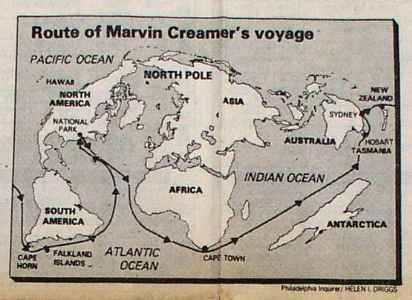Globestar Voyage
Globestar Voyage
The Globe Star Voyage, skippered by Marvin Creamer, was done entirely without the use of a compass, sextant or electronic instruments! He even refused to take a wristwatch. The sole time-measurer on board was an hourglass to indicate how long a sailor's "watch" time would be. (A sextant, compass, clock and radio were sealed in a locker below deck in case of emergency - but they remained sealed for the entire journey.) And at least the Coast Guard knew where Marv and his intrepid band of seamen were: the boat was equipped with a transmitter that sent signals at regular intervals.

Marv was and is a wizard at decoding the meaning of the water currents and wind patterns. The color and composition of the sea, cloud formations, the horizon, drifting objects and birds and insects helped -- especially when the sun, moon and stars were not visible.
Globe Star left Cape May, New Jersey, on December 21, 1982, and sailed directly to South Africa, making port at Cape Town on March 31, 1983. From there, she sailed to Australia, New Zealand, Cape Horn, and the Falkland Islands. The final leg began at Stanley on February 9, 1984, and ended at Cape May on May 17, 1984. Eleven and a half of the eighteen months were spent at sea.
"What we demonstrated is that information taken from the sea and sky can be used for fairly safe navigation. How far pre-Columbians sailed on the world's oceans we do not know; however, it is my hope that the Globe Star voyage will provide researchers with a basis for assuming that long-distance navigation without instruments is not only possible, but could have been done with a fair degree of confidence and accuracy."
